Chapter 12
Touching Your Photos and Videos
Free your photos from your home computer! Why huddle around a computer screen, when you can pass your photos from hand to hand? You can touch, explore, and interact with your captured images in a completely new way and share that experience with others. This chapter introduces you to iPhone photo and video navigation and helps you discover how to make the most of these incredibly sophisticated presentation features both for personal enjoyment and for sharing.
The iPhone’s Retina display offers beautiful, clear images at higher resolutions than ever before. Its touchscreen provides intuitive interaction controls. Its wireless Internet capabilities allow you to access a huge range of still and moving content—from YouTube to the Internet archive to your own personal computer. With your iPhone, video has entered the Internet age. This chapter introduces you to both the expected and unexpected ways you can use images and video on your iPhone.
Working with Photos
Sure, you can snap lots and lots of pictures using the onboard cameras, but you may also want to transfer images shot elsewhere to the device. There are many ways you can do this: syncing photos from your computer, saving photos from e-mailed messages, saving images found on web pages, and capturing screenshots. This chapter focuses (if you pardon the pun) on the image experience instead of using the camera. The iPhone’s camera features are introduced in Chapter 13.
Syncing Photos from Your Computer
iTunes synchronizes your iPhone with pictures stored on your computer. This allows you to bring your photo collection with you and share it using the iPhone’s unique touch-based interface. Who needs to carry around thick and heavy physical photo albums when you have an iPhone with its thin body and vibrant display?
To get started, connect your iPhone to your computer, and launch iTunes. Select your iPhone from the source list (the blue column at the left side of the iTunes window), and open the Photos tab. Check the box labeled “Sync photos,” and then choose the location of the photos you want to sync (see Figure 12–1). Your choices depend on your operating system.
On a Windows computer, your options are Adobe Photoshop Elements (3.0 or newer) or any folder on your computer, such as My Pictures. On the Mac, your options are iPhoto (4.0.3 or newer), Aperture (3.0.2 or newer), or any folder on your computer. On a Mac you’ll also need iPhoto (5.0 or newer), if you want to sync videos you’ve taken with your digital still camera.

Figure 12–1. Syncing your photos through iTunes
After choosing where to sync your photos from, select whether to sync your entire photo collection (a good choice for relatively small libraries) or individual albums (better for large libraries that might not fit on the iPhone’s limited storage space). In the latter case, pick only those albums you want to copy to your iPhone.
If you are using a Mac and iPhoto or Aperture, you’ll also have the option to sync Faces (iPhoto ’09 or newer) and Events (iPhoto ’08 or newer) albums. Faces are smart photo albums that contain all the photos that have a selected individual’s face in them. iPhoto uses built-in facial recognition software. The software “learns” as you tell it that it has or hasn’t matched the right image to the person. Faces in iPhoto doesn’t get the right match all of the time, but its accuracy isn’t too bad given that it’s an automated process. Events are another type of smart album that groups photos together that were taken on the same day. This helps eliminate clutter and keeps your photo library organized.
To finish, click Apply to save your changes and then sync.
Saving Photos from Mail and Safari
You can save photos and web page images on your iPhone without importing them from your computer or taking them with the iPhone’s camera. Here’s how you do this for each situation, using a tap-and-hold gesture to reveal a save menu.
When someone e-mails you a photo, the photos appear in the body of the message in the iPhone’s Mail app. Tap and hold your finger on any photo. A pop-up appears allowing you to save that one photo or all the photos contained in the e-mail (see Figure 12–2). The photo or photos you’ve selected to save appear in the Camera Roll in the iPhone’s Photos app.
In the iPhone’s Safari web browser, you can tap and hold your finger on any photo in a web page and select the Save Image pop-up that appears (see Figure 12–2). That photo is saved to the Camera Roll in the iPhone’s Photos app.
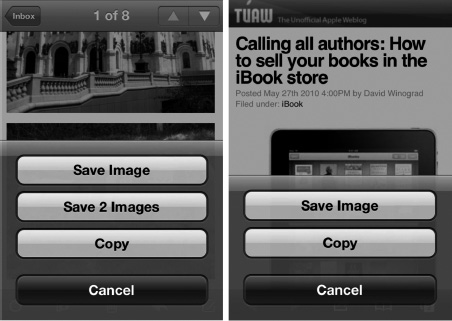
Figure 12–2. Saving photos from an e-mail (left) or a web page (right)
NOTE: Some third-party apps including web browsers and magazines also allow you to save images to your iPhone. Some apps may introduce their own, unique way of saving images, but many follow the example set in Mail and Safari.
Navigating Your Photos in the Photos App
Once your iPhone’s photo albums are populated with images, it’s time to exploring the Photos app. To launch the app, tap the Photos icon on the Home screen. It’s the one with a bright yellow sunflower on it, as shown in Figure 12–3. This is where the fun begins.

Figure 12–3. The Photos app icon has a yellow dandelion on it.
When you touch your digital photos for the first time, you feel like you’ve finally stepped properly into the 21st century—that promised utopian future where technology merges with your fondest memories, where you can go back and relive and explore them like never before. When you start pinching, dragging, and expanding your photos and albums, you’ll feel like a child again who’s just been given his first bag of marbles, spread them on the ground, and is staring wide-eyed at the colors and shapes that he can control before him.
Figure 12–4 presents the main Photo app screen, which is displayed when the app is first launched. Running along the bottom of the app is a toolbar that allows you to switch between the different ways your photos are organized. To select a view, tap its button in the toolbar.
Albums: This view displays your photos in their albums as you’ve arranged them on your computer (see Figure 12–4). You will also see a Camera Roll album if you’ve saved images from the Web or if you’ve received them in e-mail on your iPhone. If your iPhone has a camera and you’ve taken any photos with it, they also appear in the Camera Roll along with any screen captures you may have taken.

Figure 12–4. The Photos app in album view
NOTE: Did you know you can take screenshots of your iPhone? A screenshot, or a screen capture, is an image iPhone’s screen contents at the moment you snap it. To capture a screenshot, press and hold the power button on the iPhone. While holding the power button, press and release the home button. The iPhone’s screen flashes white, and you’ll hear a shutter click sound effect. Once you hear that sound, you can let go of all the buttons. The newly captured screenshot appears in your Camera Roll album. Use screenshots to save images of web pages (great for remembering movie show times) or show off that high score in a video game. Most of the images in this book were taken using the iPhone’s screen capture function.
Events: This view organizes your photos as a series of events (see Figure 12–5). Events, which are used in Aperture 2 and iPhoto ’08 and newer, are a way to automatically arrange your photos by the date they were taken. Events helps you keep large photo libraries in easy-to-navigate shape. Events is a Mac-only feature. You will not see this tab if you are syncing your iPhone with a Windows computer.

Figure 12–5. Events view
Faces: This view displays your photos grouped into an individual’s “face” album (see Figure 12–6). If you are using iPhoto ’09 or Aperture 3 on a Mac, the programs use built-in facial recognition software to establish albums of individuals and groups. It’s an amazing and fun way to see all the photos of a certain friend or family member. Faces also works to some extent on cats and dogs. You will not see this tab if you have not tagged any faces or if you are syncing your iPhone with a Windows. Like Events, Faces is a Mac-only feature.

Figure 12–6. Faces view
Places: The iPhone’s camera offers geotagging, a popular feature these days. When authorized to do so by the user, geotagging encodes the photo with the location coordinates where it was taken. The Places tab uses photo coordinates to display them on a Google map (see Figure 12–7). This is arguably the snazziest feature of Photos on iPhone because it lets you navigate your photos on a map that you can view from a global level to a street level. It’s an especially cool feature for travelers: you can see at a glance where you have been and just how much of the world is left to explore.

Red pins appear on the map signifying the geographic location of your photos. You can pinch and zoom on the map to get closer. As you do, you may see more pins appear on the map, signifying greater accuracy of the photo’s coordinates (see Figure 12–8).

Figure 12–8. More pins may appear as you zoom into an area of the map, signifying greater accuracy of the photo’s coordinates.
Tapping a pin allows an album pop-up to appear (see Figure 12–9). Tap the blue-and-white chevron button to view the Places album associated with the geographical location in question. You can then explore all the photos that were taken in that location. Places requires an Internet connection to display the Google map.

Figure 12–9. Tap a pin to see an album and thumbnail of photos that were taken at that location.
As you can now see, the iPhone’s Photos app uses its tabs to organize your photos for easy navigation. You may not see all the views on your iPhone. Categories depend on whether you are using a Mac or a Windows computer, whether you have chosen to sync albums from each category view, and whether your photos are tagged with geocoordinates.
As long as you have one photo on your iPhone, you’ll always have access to the Albums tab. For Events and Faces, you’ll need to sync the data that powers them from your computer using the software that creates those special albums. You don’t need to do anything to sync Places; its tab will appear automatically whenever your album any photos tagged with geocoordinates.
Touching and Viewing Your Albums and Photos
Navigating your photo collections is just the start of enjoying your photos. Get ready now to touch and view them. Remember all the gestures covered in Chapter 3? When viewing a collection of albums or a single image full-screen, the iPhone allows you to interact with that album or photo using a number of these gestures.
Touching and Viewing Albums
For this section, an album refers to any kind of album in Photos. The interactions with a regular album, an Events album, or a Faces album are all the same. As you can see in Figure 12–4, your iPhone might play host to many albums of many kinds. To open any album, tap it, and you’ll be taken to the album page (Figure 12–10). This page contains thumbnails of all the images inside that album.

Figure 12–10. Photos inside an album
The menu bar at the top of the screen displays the name of the album, with a back button that takes you to the category view you were previously in. It also presents a Share button (the arrow in the box in the top-right corner), which allows you to present your photos and share them with others.
To exit the album, tap the back button. The back button uses the album’s category name. In Figure 12–10, the “Favorite photos” album is part of the Albums category. The back button is always on the top left and is shaped as a five-sided pentagon, pointing left. Tap it to go back one step.
On the Places tab, the red pins on the map act as albums. This is a slightly different way of presenting albums to you. Each pin contains all the photos taken there. Tap the pin to be presented with an album thumbnail (see Figure 12–9), and then tap the thumbnail to view the album of that location.
Touching and Viewing Photos
Each album displays thumbnails of the photos it contains (see Figure 12–10). To view a photo full-screen, tap the photo once. As you can see from Figure 12–11, you can view the photo in portrait or landscape mode. Simply tilt the iPhone from horizontal to vertical or vertical to horizontal. The iPhone automatically updates the presentation to match the device orientation. If the photo was shot using landscape orientation, it fits itself to the wider view.
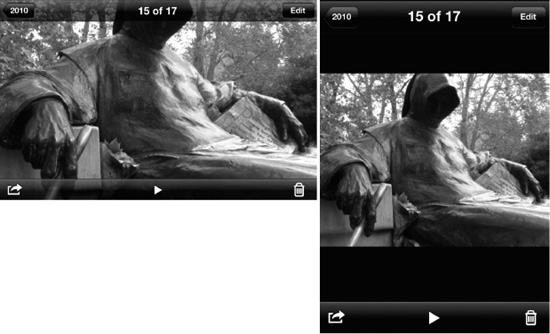
Figure 12–11. Viewing a photo in landscape and portrait modes
Interacting with Photos
Once you select and display a photo, you have several ways to interact with it. Use standard iPhone gestures to do the following:
- Pinch to zoom into and out of the photo. Pinches change the scale interactively, so you can fine-tune exactly how much to zoom.
- Double-tap to zoom into the photo using a preset zoom factor. Double-tap again to zoom out to the normal full presentation.
- Drag with your finger to re-center a zoomed-in image. After zooming into a specific face, you can move that face to the center of the screen, for example.
- When your image is displayed at the normal full-screen (zoomed-out) size, drag to the left or right to move to the previous or next image in the album. (When zoomed into an image, dragging the photo pans across it instead of moving to the next image.)
Tap any image once to invoke the image overlay shown in Figure 12–11. This overlay features a menu bar at the top and bottom of the screen, allowing you to access Photos features specific to the image being displayed. The overlay menu bar at the top of the screen indicates the number of the selected image out of the total number of images in the album and the back button to return to the album. At the bottom of the screen is the Share button and also back, play, and forward buttons. The back and forward buttons move the photos in your album back or forth one at a time. The play button allows you to start a slideshow.
You may also see an AirPlay icon (Figure 12–12, top). Looking like an upward-pointing triangle in a white rectangle, the AirPlay feature allows you to send a single photo or a slideshow to an AirPlay-enabled device, such as Apple TV (Figure 12–12, bottom). The AirPlay icon appears when you’re on the same network as an AirPlay device.
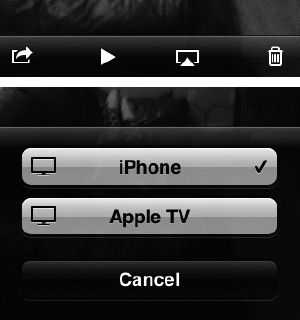
Figure 12–12. The AirPlay icon allows you to share photos and slideshows with AirPlay enabled players such as Apple TV. Tap the icon to select a destination for your photo to display on.
Viewing Your Photos as a Slideshow
When viewing the contents of any album or a single image in any album, the Share and Slideshow buttons appear at the bottom of the screen. As the name suggests, the Slideshow buttons display the contents of a photo album, one image after another as a presentation. You can play these images back locally to the iPhone screen, over a cable to an external connected TV or monitor, or wirelessly using AirPlay.
Playing slideshows on your iPhone is as easy as tapping a single button, namely, the play button that resides at the bottom center of the screen. When you tap it, your slideshow begins displaying one photo in the selected album after the next. To stop a slideshow, tap the screen.
Upon tapping the play button, the Photos application presents you with the Slideshow Options screen (Figure 12–13). Here, you can pick the presentation style and whether to play music during the slideshow.
The Transitions options vary, depending on whether you’re playing video back locally or via AirPlay to Apple TV. Apple TV offers a much wider range of slideshows (including Origami, Photo Mobile, and Ken Burns) than the relatively limited set of onboard styles (Dissolve, Ripple, and Wipes).
When you choose to play music, a new option appears on the screen called (quite obviously) Music. Tap this to open a iPod-style browser, where you can select from Playlists, Artists, Songs, and all the other built-in iPod music-selection features.
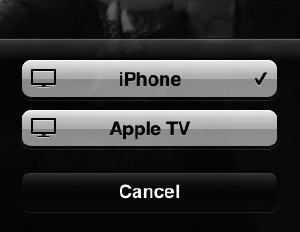
Figure 12–13. The slideshow’s options
Other Slideshow Settings
In addition to the options you see at the commencement of your slideshow, you’ll find several others in the Settings app in the Photos pane. Here, you can choose the default length of time to play each slide for (2, 3, 5, 10, and 20 seconds), whether to repeat the slideshow indefinitely, looping it at the end back to the beginning, and shuffle, which mixes up the slide playback for you.
Apple’s new Photo Stream automatically uploads all new photos to iCloud, downloading them to each of your iCloud-enabled devices. You can enable this feature in Settings ![]() Photos.
Photos.
Slideshow Tips
Slideshows offer a terrific way to share your photos with your friends and family. Remember, however, that our images are associated with our personal memories, so they are always going to be more pleasant for us to watch than for others. All you have to do is remember a time you were stuck looking at someone else’s photos, when the seconds ticked by as if they were hours. To keep your slideshows exciting for your viewers, keep a few things in mind:
Shorter is better: The average shot (a clip of video displayed between cutting away to another shot) in a movie or TV show is less than two seconds nowadays. Back in the 1950s, the average shot was 30 seconds long. Watch an episode of Friends and then an episode of I Love Lucy, and you’ll see exactly what we mean. Lucy seems to trudge along so slowly by today’s standards. As the world—and media—got faster, our attention spans shrunk. This applies to viewing still images too. People can take in a lot from an image in just two or three seconds. If they are forced to look at an image any longer, they start to get bored. Keep the time a single image is displayed short. Also, keep the entire length of the slideshow short. When you watch a movie trailer in the cinema, its time is exactly two minutes and twenty seconds—a perfect amount to whet the appetite, show people the best shots, and leave them feeling fulfilled but not exhausted.
Transitions help too: A transition is the effect that occurs when moving from one image to the next. It adds some visual flare to the change of images. Photo’s slideshows allow you to choose between a number of transitions. Use them as eye candy to keep your audience entertained, but don’t use any of the flashier ones if your slideshow is really long and people are forced to sit down and watch it directly. Stick to something simple (like dissolve); others will get tiring. If you plan to play slideshows in the background on a passive TV at a party, then Apple TV’s Ken Burns effect offers a simple presentation that offers delicious wall candy without being too distracting.
Play it in the background: If you are having a party, a great way to show off your photos without wrangling up all your guests and forcing them to sit and watch is to project your slideshow on a TV and set it to repeat. That way, your slideshow is constantly playing in the background, and your guests can continue to catch glimpses of it as they mingle. Images on slideshows playing in the background are great conversation starters and allow you to play much longer slideshows and display individual images for longer, since you don’t have to worry about a captive audience. If you are going to play your slideshows in the background, you can choose to show several thousand images for as long as five or ten seconds each; the entire show could run for hours, and it won’t get boring or tedious.
Sharing Your Photos
You have a number of ways to share photos you have on your iPhone. To access all the ways you can share your photos, bring up a photo full-screen, and tap the Share button, which looks like a curved arrow breaking free from a small box (see Figure 12–11). You’ll be presented with a pop-up menu of sharing options (see Figure 12–14).
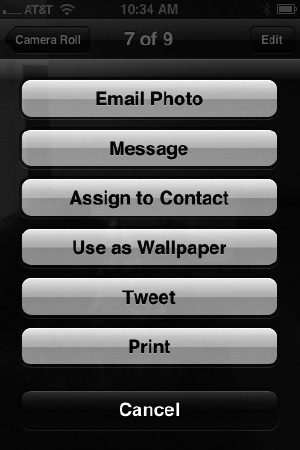
Figure 12–14. The sharing photos menu pretty much takes up the entire screen.
E-mail Photo: Tap this to open a new e-mail composition screen. The photo is automatically copied into the body of the e-mail. Enter the recipient’s e-mail, a subject, and somebody text, and then tap Send; your photo is on its way!
Alternatively, you can e-mail up to five photos at a time from within the Photos app. While in an album, tap the Share button, and you’ll see the album menu renamed to Select Photos. Tap up to five photos that you want to send, and then tap the Share button at the bottom of the screen (see Figure 12–15). A pop-up menu appears with a button that says Email. Tap this button, and an e-mail compose window appears on the screen with the photos in the body of the message.
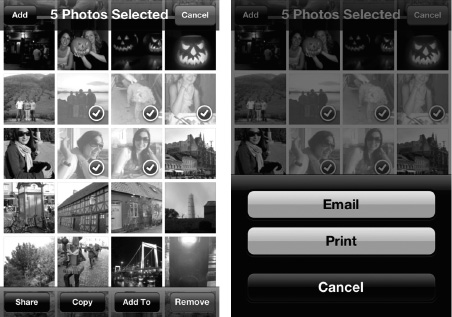
Figure 12–15. You can e-mail up to five photos at a time from within the Photos app.
Tweet: Tapping Tweet opens a Twitter upload screen. This allows you to tweet your picture directly to your Twitter account, which you have set in Settings
Twitter. Add a short message to the photo and (optionally) your current location (see Figure 12–16), and you’re ready to share your picture with the world.

Figure 12–16. Tweeting a photo
Assign to Contact: This option allows you to assign a photo to an address book contact. Tap Assign to Contact, and then select the contact’s address book entry from the pop-up menu. Move and scale the thumbnail of the photo that appears, and then tap the Set Photo button.
The next time you view the contact in the iPhone’s Contacts app, the image you selected for them appears next to their name. This image syncs with their contact info in Address Book, Entourage, and Outlook on a Mac, and Outlook on a Windows computer.
Use as Wallpaper: Tap this button to use the selected image as wallpaper on your iPhone. Move and scale the image, and then tap Set. From the pop-up menu (see Figure 12–17), you can select whether you want to use the image for the iPhone’s lock screen, the Home screen, or both.
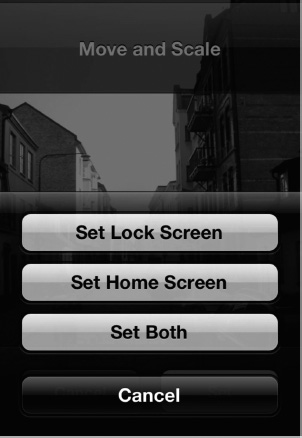
Figure 12–17. The wallpaper menu bar options let you select which screen you want to use the photo as wallpaper for.
Print: Tapping this prints your selected photo to an AirPrint wireless printer. Alternatively, you can print multiple photos from within the Photos app. While in an album, tap the Share button, and you’ll see the album menu renamed to Select Photos. Tap up to five photos that you want to send, and then tap the Share button at the bottom of the screen (see Figure 12–14). A pop-up menu appears with a button that says Print. The photos are sent to your wireless AirPrint printer. We use Ecamm’s $20 Printopia product (
www.ecamm.com/mac/printopia) to enable AirPrinting to a Brother printer. It acts as an AirPrint server and then redirects any print requests to the normally non-AirPrint-enabled hardware. Printopia also allows us to “print” my photos to Dropbox, which is also quite handy, especially for saving paper.
Managing Photos
Each album offers a photo management screen, which is shown in Figure 12–18. You enter this mode by tapping the Share button at the top-right corner of the screen. The button looks like a curved arrow escaping from a rectangle. From here, you can copy items, move them to new albums, delete them, or share them with others.
In this screen, tapping a photo selects it. A red-circled check mark appears over the image thumbnail. Tapping a second time deselects the photo. The check mark disappears.
Your management options appear in a bar at the bottom of the screen. From here, you can tap Share, Copy, Add To, or Delete/Remove.
Share allows you to share you photos with others. Tap it to choose from sharing options including Email, Message, Print, and Tweet. The last of these, the Tweet option, does not appear when you have selected multiple images because you are allowed to send only a single image at a time to the Twitter social networking service.
The Copy option allows you to copy up to five photos at a time from your photo albums. This saves the images to your clipboard for use in pasting into other applications. You can paste photos into e-mails and Pages documents, for example. If you have selected more than five photos, the Copy option grays out.
The Add To button lets you copy the selected photos to new or existing albums. When tapped, a menu appears letting you choose how to do this. Select whether your destination is a new album (you will be prompted to enter a new name) or an existing one (you will have to select the album from a pop-up). This action does not affect the original album. The new copy is added without removing the original.
Choose Delete when you want to remove the selected items from the Camera Roll. When viewing an album other than the Camera Roll, this button is replaced by Remove. Photos prompts you to confirm that deletion (by tapping Delete Photo or Remove From Album), and you can cancel out at any time before confirming. Once deleted, you cannot undo that action.

Figure 12–18. This photo management screen appears when you tap the Share button. Delete is replaced with Remove in individual albums.
Deleting Photos
Apple made it so you can only fully delete photos that are part of the Camera Roll album. Otherwise, you “remove” them from the current album. The Camera Roll album contains any photos you have saved from the Web or an e-mail or that you took with your iPhone’s camera. Apple disabled photo deletion from your other albums synced to your iPhone because it didn’t want users accidentally deleting photos they had stored on their computer; so, you can remove those items but not delete them.
In addition to using the photo management screen discussed earlier in this section, you can also delete photos using the individual display screen shown in Figure 12–19. A garbage pail appears at the bottom right of the display. As with the management screen, the role of this button depends on the current album. Tap the garbage pail when in the Camera Roll, and you’re prompted to delete everywhere. From another album, the prompt is Remove from Album.

Figure 12–19. The trash can icon in the lower-right corner of a photo allows you to delete it or remove it from an album.
To delete other photos on your iPhone, you must delete them on your computer first and then resync the iPhone.
Editing Your Photos
With iOS5, Apple has introduced photo editing to the Photos app. The photo-editing features aren’t especially advanced, but they do allow you to make some nice adjustments to your photos. Apple included four editing tools: rotate, enhance, redeye reduction, and cropping. To edit a photo, select a photo from your albums, and then click the Edit button in the top-right corner to enter Edit mode.

Figure 12–20. Editing a photo. The tools, from left to right: rotate, enhance, redeye reduction, and crop.
Figure 12–20 shows what edit mode looks like in the Photos app. The four editing tools are displayed along the bottom of the screen. Each of them offers a way to tweak your photo.
Rotate: Rotating a photo is something almost everyone has done or needs to do. Usually when a photo needs to be rotated, it’s because you took it in portrait, or vertical, orientation with your camera, but it was imported in the standard landscape, or horizontal, orientation. Tap this button (it looks like a curved arrow) to rotate the photo in 90-degree increments. Click the yellow Save button when you’ve finished rotating your photo.
Auto-Enhance: Sometimes you might take a beautifully composed photo, but the color or exposure may be off. When this happens, there’s no need to panic! The Photos app offers a one-click fix for most photos with ailments such as poor saturation or contrast; it’s called the Enhance button, and it works almost like magic. Tap the enhance button (it looks like a magic wand) to auto-enhance your photo. Enhancing a photo can really bring out details that would normally have remained hidden without doing advanced manual adjustment techniques on it in a dedicated photo editing app. Click the yellow Save button when finished enhancing your photo.
Red-eye reduction: Ah, red-eye—the scourge of photographers everywhere. We’re all familiar with red-eye. It’s the thing that makes us look like demons in photographs—the red halo that appears in people’s eyes that is caused by the way the human eye reflects the camera’s flash. Luckily, most of the cameras on the market today offer built-in red-eye reduction, but the iPhone does not. It won’t reduce red-eye while you’re taking the picture, but if your iPhone takes photos in which your friends look like they’re about to unleash some heat vision, the Photos app’s red-eye reduction tool makes it easy to eliminate the red tint.
To eradicate red-eye in your photos, tap the red-eye tool (it looks like a red dot with a line through it). Next, tap each eye of the person (Figure 12–21). Like magic, their red eyes gain a more natural color. Click the yellow Apply button when finished.
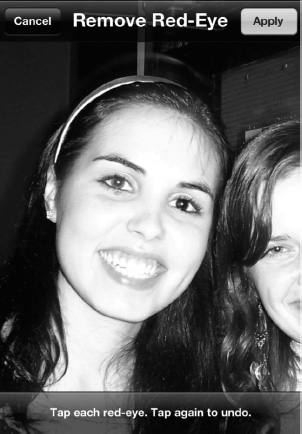
Figure 12–21. Reducing red-eye in your photos. In this photo, the right eye has had red-eye reduction applied, while the left eye has not.
Crop: Crop your photos to remove unwanted portions of them. To do this, tap the crop button (it looks like a square). Crop gridlines appear, helpfully laid out using rule-of-thirds proportions (Figure 12–22).
One of the rules for good composition is truly “classic.” The ancient Greek and Egyptian philosophers discovered an important feature about beauty. Much of what we find attractive and beautiful incorporates a specific ratio, which is approximately 3:2. They called this ratio Phi (rhymes with “tie”), the “golden ratio,” or even the “divine ratio.” You can find this mathematical relationship abundantly in nature, such as in the way a tree grows, flowers bloom, or our body parts (fingers, hands, arms, and so on) are laid out.
The ancients incorporated this idea into their art and architecture. It was this transference from nature into art that came to be known as the rule of thirds. Basically, the rule is that things that are split into thirds, with features placed at the one-third mark and/or two-thirds mark, look better than things with more arbitrary placements. It’s as simple as that.
When you place features along the rule-of-thirds lines, especially at the four intersections, you’ll end up with better-composed scenes. Drag the gridlines around until you’ve selected the portion of the photo you want to crop. Click the yellow Crop button to apply the crop.

Figure 12–22. Cropping a photo. Notice how the major features have been adjusted to fit the rule-of-thirds grid lines.
You can also constrain the aspect ratio of the crop so you’ll know the exact ratio between the height and width of the photo once you are done cropping it. To constrain a photo’s aspect ratio, click the Constrain button at the bottom of the crop screen (Figure 12–22). The constraints screen appears (Figure 12–23).
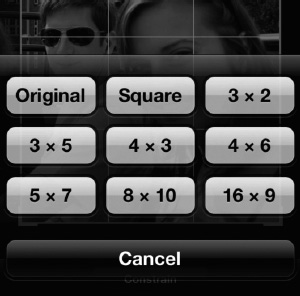
Figure 12–23. Constraining a crop’s aspect ratio
Tap the desired aspect ratio. This matches the crop box to the specific ratio you selected. The rule-of-thirds grid updates to the new aspect. You can then drag the constrained crop box around knowing that no matter where you crop, the photo will match the selected ratio. Beware: If you drag the handles at the edges of the constrained box, you will lose that aspect ratio. To get it back, tap Constrain one more time, and again select the desired aspect.
Tap the yellow Crop button when ready to crop your photo, and then tap the yellow Save button to save your cropped photo.
NOTE: You can straighten a photo while in crop mode. With the crop grid in place, use two fingers to “twist” the image left or right. As you do, additional grid lines appear to help you align your photo.
iPhone Video Applications
Video forms such a basic component of your iPhone that you shouldn’t think about it as just a single application. Apple provides the base technology used by several different programs. You’ll find several applications that support video playback on your iPhone (see Figure 12–24).

Figure 12–24. Your iPhone provides not one but three primary applications that support video playback: Safari, YouTube, and Videos. What’s more, there are any number of third-party apps that play videos as well.
Videos: The Videos application appears on the Home screen of your iPhone. The icon looks like a traditional clapperboard, with a black-and-white striped top over a blue base. This application plays back TV shows, movies, podcasts, iTunes U lessons, and music videos you’ve synchronized from your home iTunes library.
YouTube: You’ll find the YouTube application icon next to the Videos app in Figure 7–1. The icon looks like an old-fashioned TV, complete with a greenish screen and brown dials. YouTube connects to the Internet and allows you to view videos from YouTube.com. You can navigate to
http://youtube.comin Safari on the iPhone and browse and watch YouTube videos that way, but the iPhone’s YouTube app wrapshttp://youtube.comin such a nice and easy-to-navigate package, you’ll find it is leaps and bounds better than using YouTube in a web browser.Safari: Safari, which you read about in depth in Chapter 4, offers a third way to view videos. Like its computer-based equivalents, the Safari app allows you to watch embedded movie files. Safari’s icon looks like a light blue compass with a needle pointing to the northeast.
In addition to the three apps that play video that come with the iPhone, there are thousands of other apps that play video. You can discover all these apps in the iTunes Store. Some of our personal favorites are YXPlayer, which allows you to view videos from a personal camcorder (it records in AVI format), the BBC News app to view news footage, and the Weather Channel app to watch weather-related news stories and Doppler video.
NOTE: Apple’s latest iPhone officially supports the following video formats: H.264 video up to 1080p, 30 frames per second using High Profile level 4.1 AAC-LC audio. This includes up to 160 Kbps, 48kHz, stereo audio in .m4v, .mp4, and .mov file formats; MPEG-4 video up to 2.5 Mbps, 640 by 480 pixels, 30 frames per second; Simple Profile with AAC-LC audio up to 160 Kbps per channel, 48kHz, stereo audio in .m4v, .mp4, and .mov file formats; Motion JPEG (M-JPEG) up to 35 Mbps, 1280 by 720 pixels, 30 frames per second, audio in ulaw, PCM stereo audio in .avi file format.
You can use AirPlay Mirroring up to 720p, 30 frames per second, normal video mirroring and video out up to 1080p using the Apple Digital AV Adapter and Apple VGA adapter, up to 576p and 480p with the AV Component cable, and 576i and 480i with the AV Composite cable.
For all that the iPhone brings to video, it has limits. Your iPhone plays files using H.264 MPEG-4 video and its immediate family, and that’s pretty much it. You cannot use your iPhone to natively view Flash/Shockwave videos or animation; to play AVI videos or DivX, Xvid, Matroska video; or to play any of the other dozens of popular formats. If your video isn’t in MPEG-4 H.264 format, by default, your iPhone won’t understand it.
That doesn’t mean you cannot purchase a third-party product to handle some of these playback duties, but there’s usually compromises involved especially for flash media playback.
We am very fond of the VLC/FFMPEG families of video players based on GNU-licensed open source media players. Unfortunately, because of licensing issues, the best of these clients—the official (and free) Video Lan Client app—was pulled from the App Store. We have had good success using YXPlayer, and there are any number of other smart media players as well. Check the reviews carefully when making your purchases.
For the most part, it’s very easy to play AVI and MKV video on the iPhone using one of these third-party players. Pretty much universally, they permit you to add files in iTunes—whether they are from your personal video recorder or from a Windows-based capture card—and play them back on your iPhone on the road. You can then delete them from within the application as you’re on the go, to free up space as needed.
Another solution is provided by transcoding servers like AirVideo and StreamToMe. For a few dollars, they provide an iPhone-based client that you purchase and a free server component that you install on your home computer, be it a Mac or Windows system. (There are even a few Linux-based solutions out there.) The server uses transcoding—converting the data in real time from its native format like AVI to an iPhone-friendly MPEG-4 version, which you can watch as it streams over a Wi-Fi connection.
Both of these approaches, a native multiformat player and the streaming transcoder, are traveler friendly, whether you’re commuting on the train or bus or on a business trip.
Video Playback
iPhone video is primarily a wide-screen feature, unlike audio, which plays back in both portrait and landscape orientations. You must usually flip your iPhone on its side to view TV shows, video podcasts, movies, and music videos. Select any video—from Safari, YouTube, or Videos—to begin playback, and then flip your iPhone on its side to watch. The Home button goes to your right. Safari and YouTube provide exceptions to the landscape-only rule; in those applications, you can also watch videos in portrait orientation.
Depending on the app you are watching it in, you may see more options for the video being played or for the app itself. However, most apps display the same elements in the video interface, meaning once you know how to control video playback in one app, you know how to do it in the rest of them. Here is a quick overview of those controls, which are shown in Figure 12–25.

Figure 12–25. The iPhone’s video playback controls allow you to control playback as you watch.
Play/Pause: Play/Pause appears as either a right-pointing triangle (Play) or a pair of vertical lines (Pause). Tap this button to pause or resume video playback.
Rewind: The Rewind button appears as two triangles pointing left to a line. Tap it to return to the start of the video, or press and hold the button to scan backward.
Fast-Forward: The reverse of Rewind, the Fast-Forward button’s triangles point to the right instead of the left. Press and hold this button to scan forward. Tap it to skip to the next video track.
AirPlay: A rectangle outline with a solid triangle at its base, this option allows you to select an AirPlay destination for your video, typically an Apple TV. Choose iPhone from this menu to revert video display back to the device screen. You’ll find the AirPlay button at the right side, just above the volume control. You will not see this option when you do not have a secondary AirPlay destination connected on your current network.
Scrubber bar: The scrubber bar appears at the top of your screen. It is a long line with a small knob that you can drag. (The volume control is the thicker bar at the bottom.) Drag the playhead along the scrubber bar to set the current playback time.
Zoom: The Zoom button looks like two arrows pointing away from each other, at the top-right of your screen. Either double-tap the screen or tap the Zoom button to switch between full-screen mode and original aspect ratio. To get back into the original aspect ratio’s view, double-tap the screen again, or tap the zoom button again. You’ll note that the zoom button changes slightly when viewing a video full-screen: the arrows have turned into a letterbox icon. When viewing in full-screen mode, you use the entire iPhone screen, but some video may be clipped from the top or sides of the video. In original aspect ratio, you may see either letterboxing (black bars above and below) or pillarboxing (black bars to either side), which results from preserving the video’s original aspect ratio.
Volume: The volume control is the large line below the play/pause buttons. Drag the volume control knob to adjust playback volume. Of course, you can always use the dedicated physical volume button on the side of the iPhone as well.
Audio tracks and Subtitles: If alternate audio tracks or subtitles are available in the video you are watching, you’ll see an icon that looks like a speech bubble appear in the play/pause bar. Tap this icon to select from a pop-up list of audio tracks and subtitles.
Done: The Done button appears on all video application screens. Tap Done to exit video playback. Press the physical Home button on the iPhone’s bezel to quit the app and return to your Home screen.
While you’re playing a video, the iPhone automatically hides your video controls after a second or two. This allows you to watch your video without the distraction of on-screen buttons. Tap the screen to bring back the controls. Tap the screen again to hide them, or leave them untouched for a few seconds, and they once again fade away.
YouTube
The YouTube app requires an Internet connection, so as long as you have a Wi-Fi connection, you’re all set. But to take full advantage of the YouTube app, you’ll want to have a YouTube account. You don’t need a YouTube account to use the app, but having one makes the app that much more powerful. With a YouTube account, you can view and bookmark your favorite videos; subscribe to YouTube users videos; see all the videos you’ve uploaded to YouTube with the tap of a button; and share, rate, and flag videos—all from within the YouTube app. Creating a YouTube account takes only a few minutes and can be done at www.youtube.com/create_account.
To launch the application, tap the YouTube icon, which looks like a retro-styled TV set (see Figure 12–26). When launched for the first time, the application displays the Featured screen, as shown in Figure 12–27. This screen showcases YouTube’s notable videos.

Figure 12–26. The YouTube app

Figure 12–27. YouTube’s Featured screen provides a video showcase.
Here are a few interaction elements you’ll find on most YouTube video-listing screens:
Play a video: Tap the image or name of a video to begin playback. Your iPhone connects to YouTube, downloads the video, and plays it for you.
View a video’s info screen: Tap the More Info button (the blue circle with the right-pointing white chevron) to learn more about the video. Read more about the info screen later in this chapter, in the “Viewing Video Info Screens” section.
Select another listing screen: Choose any button along the bar at the bottom of your screen. You’ll jump to the associated built-in YouTube screens: Most Viewed, Search, Favorites, and so on. Each of these screens helps you find and view YouTube videos. You can customize this buttons bar to change the buttons it contains.
Playing YouTube Videos
To play a video, tap the name or image of the video. The video appears in full-screen, as shown in Figure 12–28.

Figure 12–28. Playing a YouTube video
From this screen you can interact with the video in the following ways:
Scrubber: At the top of the screen you’ll see the scrubber bar. This allows you to scrub, or advance or go back, through a video. The silver dot symbolizes where you are in the video, and the white part of the scrubber bar symbolizes how much of the video has downloaded. You can skip ahead to undownloaded portions of the video, and the YouTube app starts downloading the video from that point on.
Bookmark: The bookmark button looks like a book and allows you to save a video to your favorites for easy, quick access. It is found above and to the far left of the volume bar.
Rewind, play/pause, and fast-forward: These standard buttons allow you to rewind, play or pause, and fast-forward through a video.
AirPlay: Use the AirPlay button (rectangle with up-pointing triangle) to redirect your video to an external AirPlay-enabled destination, typically Apple TV. You will not see this option if an AirPlay destination is not available on your network.
Share: This Share button allows you to send an e-mail with a link to the YouTube video in the body of the message. You can also add the video to your Favorites or tweet a link to the video. This allows you to share your favorites immediately after you watch them.
Volume slider: Located at the bottom of the screen, this allows you to adjust the volume of the video to the most comfortable audio levels.
Done: Tap this button in the upper-left corner to exit the video and return to its Info page.
Finding YouTube Videos
Each button on the buttons bar offers a different way to list YouTube videos. To find videos, tap any of these buttons:
Featured: This screen lists videos reviewed and recommended by YouTube staff. These are usually pretty high quality and worth checking out.
Most Viewed: This screen lists the most popular videos of the day, week, or all time. The All Time screen is great, because it’s interesting to see a list of the planet’s most-viewed videos.
Search: On this screen, enter a keyword or two, and then tap Search to look through YouTube’s entire collection.
Favorites: This screen is for a collection of videos you’ve selected and bookmarked. Easy access to your favorite videos is always a plus because it saves you time from searching for them again.
More: Choose from six more viewing choices or customize the display:
- Most Recent: Showcases YouTube’s newest items. Some might be good; others not.
- Top Rated: Lists YouTube’s collection of videos that have garnered the most viewer support. This is the wisdom of the masses, so starred videos might not equal quality in every case.
- History: Displays recently viewed items. This is handy if you remember you watched a hilarious video but can’t remember the exact name of it.
- My Videos: Displays all the videos you’ve uploaded to YouTube. This feature requires you to be logged in to your YouTube account.
- Subscriptions: Allows you to subscribe to another YouTube user’s videos so you can keep up-to-date with the latest videos they’ve posted. Any subscriptions you have show up on this screen. Tap the name of the user to see all their videos displayed to the left of the list. This feature requires you to be logged in to your YouTube account.
- Playlists: Creates playlists of videos. When signed in, you can see any playlists you’ve created on YouTube.com. Playlists are handy because it lets you group related videos together (for example, exercise videos).
- Edit lets you choose which items appear on your shortcuts bar and which appear on the More screen.
On each of these screens, you can scroll up and down the listings and play back any video by tapping its name or icon.
Customizing the YouTube Buttons Bar
The buttons bar at the bottom of your screen is fully customizable, so it can provide quick access to the categories you view the most. Tap More ![]() Edit to make changes. Available categories appear in the screen above the bar, as shown in Figure 12–29. Select the ones you want to use, drag them down to the buttons bar, and then tap Done.
Edit to make changes. Available categories appear in the screen above the bar, as shown in Figure 12–29. Select the ones you want to use, drag them down to the buttons bar, and then tap Done.

Figure 12–29. Use this Configure screen to choose which buttons appear in the bar at the bottom of the YouTube application.
Here are a few pointers about how this customization works:
- The buttons bar always contains four category buttons plus the More button. You cannot add more buttons or remove buttons to display fewer options.
- You cannot replace More with another button.
- If you replace a button with an item already in the buttons bar, the two items switch positions.
- There is no “revert to defaults” option. The original order is Featured, Most Viewed, Search, and Favorites.
- The items you do not include in the buttons bar appear as a list when you tap More. You can select them from that list. It’s an extra step, but all the options are still available.
Viewing Video Info Screens
Video information screens provide a detail view for each video. Figure 12–30 shows a typical info screen. Here, you’ll find the name of the video, its rating (in stars, from zero to five), the number of times the video has been viewed, its run time, and more. Scroll down the screen to find YouTube’s suggestions for related videos.

Figure 12–30. A video info screen offers information about the video and the option to bookmark the video.
Here is also where you’ll find the Add to Playlist and Share buttons.
Add to Favorites: Marks the video as one of your favorites and adds it to your Favorites bookmark list.
Add to Playlist: Adds the video to one of your YouTube playlists
Share Video: Creates an e-mail with a link to the YouTube video in the body of the e-mail. You can also tweet a link to the video.
To get more information about the video, tap the blue-and-white chevron button. This takes you to the More Info screen (Figure 12–31). From this screen you can read more about the video; read comments; and rate, comment, or flag the video. Tap the More Videos tab to see move videos from the user.

Figure 12–31. A video’s More Info screen gives you information about the video, links to more videos by the same uploader, and (if you scroll down) user comments.
The Videos App
Long gone are the days when keeping entertained on long car trips required a portable DVD player and a case of discs. The iPhone’s Video app lets you carry around your favorite movies, TV shows, and podcasts in your pocket and switch between them with a tap of your finger.
The Videos application icon (Figure 12–32) is colored blue and has a traditional, striped clapperboard top. Tap it to launch the program. This opens the screen shown in Figure 12–33.

Figure 12–32. The Videos app
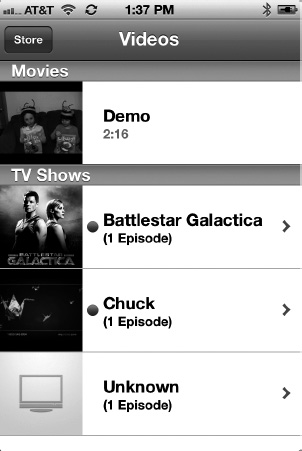
Figure 12–33. The Videos app offers a list of music videos, TV shows, movies, and video podcasts you’ve synchronized to your iPhone. Episodes that are currently syncing (see the sync icon in the status bar) appear as “Unknown” until the data is finished downloading.
As you can see, the Videos interface couldn’t be simpler. It displays a series of thumbnail images representing the music videos, TV shows, podcasts, and movies you’ve synchronized to your iPhone (Chapter 2 introduces the art of synchronizing these items). Tap any item to begin playback. Your screen clears, and the video loads and automatically begins playing. Tap Done to return to the list screen, or press Home to quit and go to your Home screen.
Tapping the Store button in the top-left corner of the screen takes you to the iTunes Store app (discussed in Chapter 7) where you can buy music and videos.
If you tap a TV show or podcast, you’ll be taken to an additional page (Figure 12–34) that lists all the episodes for the TV show or podcast that you have on your iPhone before the video begins playing. From this screen, tap the episode you want to play or tap the Get More Episodes… button to be taken to the show’s iTunes Store page where you can download additional episodes.

Figure 12–34. A TV show’s page in the Videos app
Deleting Videos on the Go
The iPhone allows you to recover space on the go by deleting videos after you’ve watched them. To take advantage of this feature, go to the Videos screen and swipe through the name of any video. A red Delete button appears to the right of the video name. Tap Delete to remove the video, or tap anywhere else on the screen to cancel and keep the video.
Choose your videos wisely. Even with newer iPhones with expanded memory, videos can quickly eat up your free space. And don’t be shy about deleting your videos on the go. You can always sync them back on your home computer.
Getting Videos
The easiest way to get compatible official videos on your iPhone is to buy or rent them from the iTunes Store. Check out Chapter 7 for more details on buying and renting movies. You can also rip DVDs you own using desktop applications like Handbrake (http://handbrake.fr). Keep in mind local laws may prevent you from ripping DVDs, even if you own them.
If you take home movies using small portable “flip”-style video recorders, your video may not be compatible with Apple’s Videos software. In this case, you can use Handbrake-style tools to convert them to H.264 compatible movies, or you can purchase third-party applications that handle their format natively. Typically they record using AVI. Bringing home movies along to share on trips can be a great way to share your life with others, but plan in advance so your video formats don’t trip you up during playback. Another great way, of course, to virtually “share” your kids, your spouse, and your friends is to use FaceTime for live video conferencing between iPhones.
Video Settings
Several settings affect your video playback. These settings are accessed through the iPhone’s Settings application (see Figure 12–35) and control how your video is played on your iPhone and when your iPhone is connected to your TV. Choose Settings ![]() Video to view them.
Video to view them.
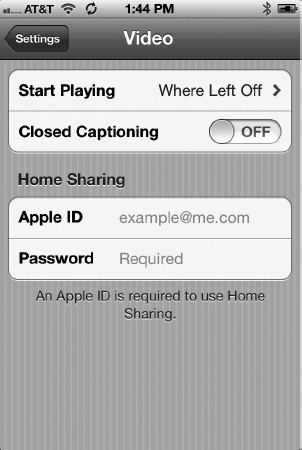
Figure 12–35. The Video app’s settings
For your iPhone video settings:
Start Playing: Choose whether to start playing videos from the beginning or where you left off. If you do a lot of product demos, set this option as “from the beginning.” That way, each time, you’re ready to demonstrate using freshly queued up videos. If you’re a commuter who catches just a bit of your favorite show at a time, leave it set as “Where left off.” This allows you to keep watching sequentially, picking up each time from your previous stopping point.
Closed Captioning: If your video contains embedded closed captions, you can view them by switching on the Closed Captioning option. Switch the option from Off to On. Closed Captions aren’t just for the hard of hearing. They can help out when you’re viewing videos in noisy conditions such as on public transportation or when your training seminar accidentally got scheduled next to a construction zone.
Home Sharing allows you to share media assets over a local network without having to sync those items over to your iPhone. It provides a live feed of data from any home computer registered to your Apple ID. For your Home Sharing settings to work, your iPhone and computer must be connected to the same wireless network, and iTunes must be open on your computer for your iPhone to see its videos.
NOTE: Unfortunately, the iPhone does not allow you to turn off your screen and continue listening to the audio track from your video. Tap the Sleep/Wake button, and your video playback ends. You can, however, diminish the screen brightness levels in Settings ![]() Brightness. This is not much of a win. Your iPhone continues using (energy-consuming) video decoding to play back video as well as audio.
Brightness. This is not much of a win. Your iPhone continues using (energy-consuming) video decoding to play back video as well as audio.
Watching Videos on the Web with Safari
Video on the iPhone isn’t limited to special-purpose applications. You can also watch MPEG-4 movie files with the iPhone’s Safari application. Chapter 4 introduced Safari. Here you’ll see how you can connect to video on the World Wide Web and watch it in your Safari browser.
Many web sites besides YouTube feature embedded video. For example, go to virtually any news site, and you’re sure to find embedded video. The iPhone, and thus Safari, does not support Flash playback natively, which limits the iPhone’s ability to display every single video on the Web. However, many web sites now serve HTML5 and MPEG-4 videos, and these are fully iPhone-compliant. HTML5 is particularly exciting because it’s an open web standard that allows developers to create fully interactive content that is optimized and compatible to today’s (and tomorrow’s) touchscreen devices. HTML5, unlike Flash, does not require that the user download and install a special plug-in to view video content.
For example, the web site TED (www.ted.com) where you can watch videos of some of today’s greatest minds talk about science, education, technology, and art is fully iPhone-compatible, and it achieves this by being written in and having the videos encoded in HTML5. Figure 12–36 shows this site’s video of author Elizabeth Gilbert talking about creativity playing back in the iPhone’s Safari web browser.

Figure 12–36. Many videos on the Web can be played natively in the Safari web browser.
Tap an embedded video to begin playing it. The video opens in the usual video playback window, and you’ll have the option of using AirPlay to redirect the video to an AirPlay-compatible destination if one is available on your local network. Depending on the speed of your Internet connection, it may take a few seconds before the video begins playing. Watch the video, and when you’re done, tap the Done button in the video playback screen to return to the Safari web page.
Streaming Video to Your Apple TV with AirPlay
Just as Home Sharing allows you to stream video from your iTunes library on your computer to your iPhone, another technology called AirPlay lets you stream video from your iPhone to your AppleTV.
An Apple TV is an inexpensive (US$99) set-top box that you plug into your HDTV. With this box, you can rent movies and TV shows from the iTunes Store directly on your TV. The Apple TV connects to the Internet wirelessly and also communicates with your computer, iPhone, iPhone, or iPad wirelessly. Once you have your Apple TV set up, start watching a video on your iPhone, and then tap the AirPlay icon (Figure 12–37) that appears in a video’s control bar to instantly stream that video to your TV.

Figure 12–37. The AirPlay icon appears in a video’s control bar when your iPhone detects nearby AppleTVs or potentially other AirPlay receivers when third-party units become available.
AirPlay is, essentially, the opposite of Home Sharing. Instead of sending data from a nearby computer to your iPhone, AirPlay allows you to redirect video or audio to an external player. It’s a particularly handy feature because you can start watching a video on your iPhone on your commute home from work, and when you get home, you can finish watching the video on your TV with the tap of a button.
AirPlay also allows you to mirror your iPhone 4S screen to the big-screen TV for live gaming and product demos. This option is not available on earlier iPhone units. To access this option, you’ll need to follow these steps. First, double-click the Home button to reveal the recent applications tray. Swipe your finger from left to right twice. The first swipe brings you to playback controls. The second to volume and AirPlay (see Figure 12–38).
Here, you’ll find yet another AirPlay control. Tap it to select your AirPlay destination. Instead of rerouting video, however, it will mirror your entire screen.
Some applications are smart enough to use this feature in another way. Instead of standard mirroring, they treat that external AirPlay destination as a second—very large—output screen, allowing you to use your iPhone for game controls and your home HDTV for game play.
This feature is just coming online as this book was being written, so we do not as-yet have specific games to recommend, but keep your eye out for this option. It’s going to be one of the most compelling reasons to purchase the iPhone 4S model because nothing beats gaming on a very, very, very big screen.

Figure 12–38. AirPlay mirroring is available exclusively on the iPhone 4S and newer and the iPad 2 and newer.
Video Accessories
As far as video goes, there are several iPhone accessories besides the AppleTV you may consider purchasing.
Stands: Several companies make them, and they range in price, typically from $5 to $30. Whatever stand you choose, if you are planning to prop the iPhone up while watching video, make sure it holds the iPhone steady in landscape mode. By the way, business card holders make excellent stands for use while you’re traveling on airplanes.
iPad Dock Connector to VGA Adapter ($29): Yes, its name says “iPad,” but it works just fine with the iPhone. The VGA end of the adapter can be connected to external monitors, some TVs, and PC projectors. You’ll need this or the cables below to connect your iPhone to your home television.
Apple Component AV Cable ($49) and Composite AV Cable ($49): These also work with the iPhone, providing two more methods of linking external monitors and projectors to the device.
Apple Digital AV Adapter ($39)This cable links your iPhone to HDMI output, so it can be used with most HDMI television sets.
Each of these cables are types of physical video connectors that link devices to TVs.
- VGA is a 15-pin connector that you can still find on the back of many PCs. It supports resolutions up to 2048×1536.
- Composite is a video connector that channels three video source signals through a single connection. It’s the oldest of the three technologies but still supports a resolution of up to 720×576i.
- Component is a video connector that takes three video source signals and outputs them through three different connections. It’s basically a Composite cable with three heads, but Component offers a much better resolution, up to 1920×1080p (otherwise known as “Full HD”). The Apple adapter can output up to 576p, even though the format is more capable than that.
- The Apple Digital AV Adapter provides HDMI-compatibility with up to 1080p output. It is also compatible with the fourth-generation iPod touch and all models of iPad.
Many modern TVs provide compatibility with some or all these connections. Check your TV’s manual to see which yours supports.
Summary
This chapter introduced you to the iPhotos app of the iPhone and showed you how to navigate your photo collections in a variety of ways. It also demonstrated how your iPhone’s wide-screen video features and interactive touchscreen are in a class of their own. They offer clear, easy-to-watch video on a (relatively) large screen. In this chapter, you’ve seen how to watch video from YouTube, the Videos application, and Safari. Here are a few points you should take away and consider:
- The iPhone’s Photos application offers some of the most instantly appealing ways to show off the power of your iPhone. You can scroll through your albums, zoom in and out with a pinch or double-tap, and flip the unit on its side. These features all deliver the iPhone wow factor.
- You aren’t limited to just viewing photos on your iPhone, you can also apply simple edits to them to make them look their best and use AirPlay to send slideshows to your Apple TV.
- You have several ways to navigate your photos: by album, by face, by event, or by place. By far the coolest way is Places, which shows you your photos on a map, based on the location where they were taken.
- Consider investing in an inexpensive business card holder as a stand for your iPhone. It makes watching slideshows on your iPhone a lot easier, especially for more than one person at a time. A video-out cable from Apple increases the fun by sending the slideshows to a TV screen.
- Apple TV may seem like a $99 boondoggle, but once you have one, you’ll discover just how wonderful it is to be able to redirect your iPhone 4S’s video output to the big screen. Plus, being able to present slideshows at parties is a great way to add a unique personal touch to your decorations.
- Pick the YouTube listings that you like best. The buttons bar at the bottom of the screen is fully customizable. If you prefer to view the Top Rated videos over the Most Viewed, feel free to drag that option to your bar.
- Use the red Clear button at the top-right corner of the History screen to erase your YouTube viewing history. People don’t have to know you’ve been watching that skateboarding dog.
